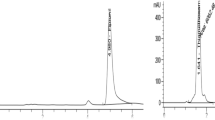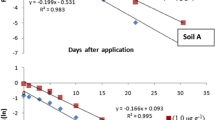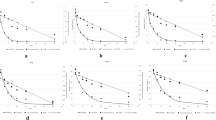Abstract
Furan tebufenozide is a newly developed insect growth regulator and has been applied as a pesticide in agriculture in China. Its degradation under both laboratory and field conditions was investigated, and the degradation kinetics was fitted by simple first order kinetics (SFO) model and first order double exponential (FOD) model. Laboratory studies were conducted with or without light in five simulated media (sterilized deionized water, river water, soil solution, sterilized soil and natural soil). No dissipations of furan tebufenozide were observed in sterilized aqueous and soil media under light prevented conditions, whereas degradation occurred under all the other conditions in the laboratory. Derived from SFO and FOD models, DT50 in the dark and light laboratory conditions was in the range of 39.7–82.5 and 1.1–8.0 days, respectively. These results indicated that microbes and light were the main factors for the degradation of the pesticide in the laboratory. During field trials, derived from the SFO model, DT50 and DT90 were 30.3 and 100.5 days, while derived from the FOD model, DT50 and DT90 were 28.9 and 274.9 days, respectively. Compared with laboratory experiments, field trials were influenced by multiple factors. Therefore, the SFO model could not fit experimental data as well as the FOD model did in field trials.
Similar content being viewed by others
References
Harir M, Gaspar A, Frommberger M, Lucio M, El Azzouzi M, Martens D, Kettrup A, Schmitt-Kopplin P. Photolysis pathway of imazapic in aqueous solution: ultrahigh resolution mass spectrometry analysis of intermediates. J Agric Food Chem, 2007, 55: 9936–9943
Rafqah S, Aamili A, Nelieu S, Kerhoas L, Einhorn J, Mailhot G, Sarakha M. Kinetics and mechanism of the degradation of the pestic metsulfuron methyl induced by excitation of iron aqua complexes in aqueous solutions steady state and transient absorption spectroscopy studies. Photochem Photobiol Sci, 2004, 3: 296–304
Boesten J, Linden A. Modelling the influence of sorption and transformation on pesticide leaching and persistence. J Environ Qual, 1991, 20: 425–435
Kah M, Beulke S, Brown CD. Factors influencing degradation of pesticides in soil. J Agric Food Chem, 2007, 55: 4487–4492
Walker A, Jurado-Exposito M, Bending GD, Smith VJR. Spatial variability in the degradation rate of isoproturon in soil. Environ Pollut, 2001, 111: 407–415
Gennari M, Abbate C, Baglieri A, Negre M. Fate and degradation of triasulfuron in soil and water under laboratory conditions. J Environ Sci Health B, 2008, 43: 498–505
Marquis LY, Comes RD, Yang CP. Degradation of fluridone in submersed soils under controlled laboratory conditions. Pestic Biochem Physiol, 1982, 17: 68–75
Zhang XG. Novel insect growth regulator furan tebufenozide. World Pestic, 2005, 27: 48–49
Xu NF, Zhang Y, furan tebufenozide suspension concentrate and its producing method. China Patent, 200510129205.0, 2005-10-12
Mao CH, WANG QM, Huang RQ, Bi FC, Chen L, Liu YX, Shang J. Synthesis and insecticidal evaluation of novel N-oxalylderivatives of tebufenozide. J Agric Food Chem, 2004, 52: 6737–6741
Gee GW, Bauder JW. Particle-size analysis. Am Soc Agro, 1986. 383–412
Chhabra R, Pleysier J, Cremers A. The measurement of the cation exchange capacity and exchangeable cations in soils: a new method. Proc Int Clay Conf, 1975, 319–333
Krogh KA, Jensen GG, Schneider MK, Fenner K, Halling-Sørensen B, Analysis of the dissipation kinetics of ivermectin at different temperatures and in four different soils. Chemosphere, 2009, 75: 1097–1104
Siddique T, Okeke BC, Arshad M, Frankenberger WT. Temperature and pH effects on biodegradation of hexachlorocyclohexane isomers in water and a soil slurry. J Agric Food Chem, 2002, 50: 5070–5076
Kwon JW, Armbrust KL, Grey TL. Hydrolysis and photolysis of flumioxazin in aqueous buffer solutions. Pest Manag Sci, 2004, 60: 939–943
Kepner Jr RL, Pratt JR. Use of fluorochromes for direct enumeration of total bacteria in environmental samples: past and present. Microbiol Mol Biol R, 1994, 58: 603–615
Bell C, McIntyre N, Cox S, Tissue D, Zak J. Soil microbial responses to temporal variations of moisture and temperature in a chihuahuan desert grassland. Microb Ecol, 2008, 56: 153–167
Author information
Authors and Affiliations
Corresponding authors
Rights and permissions
About this article
Cite this article
Guo, C., Li, D., Chen, J. et al. Degradation of furan tebufenozide in laboratory and field trials. Sci. China Chem. 53, 1818–1824 (2010). https://doi.org/10.1007/s11426-010-3168-z
Received:
Accepted:
Published:
Issue Date:
DOI: https://doi.org/10.1007/s11426-010-3168-z




